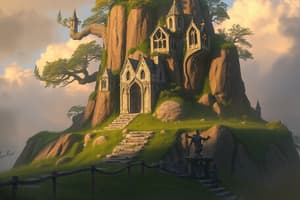Podcast
Questions and Answers
What is the most common structure used in traditional storylines?
What is the most common structure used in traditional storylines?
Three-act plot structure
What does the backstory in a game do?
What does the backstory in a game do?
- Introduces gameplay mechanics
- Describes character statistics
- Provides information leading up to the game’s beginning (correct)
- Offers player ranking
What is the focus of Act I in the three-act structure?
What is the focus of Act I in the three-act structure?
The character’s problem
What typically occurs in Act II of the three-act structure?
What typically occurs in Act II of the three-act structure?
How does a story typically conclude in Act III?
How does a story typically conclude in Act III?
What defines the theme of a story?
What defines the theme of a story?
What does the setting represent in a game story?
What does the setting represent in a game story?
Flashcards
Most common story structure?
Most common story structure?
The three-act plot structure is the most common structure.
Purpose of backstory?
Purpose of backstory?
Backstory provides information leading up to the game’s beginning, setting the stage for the current events.
Focus of Act I?
Focus of Act I?
Act I focuses on introducing the character and the central problem they face.
Typical events in Act II?
Typical events in Act II?
Signup and view all the flashcards
Typical conclusion in Act III?
Typical conclusion in Act III?
Signup and view all the flashcards
What defines a story's theme?
What defines a story's theme?
Signup and view all the flashcards
What does the setting represent?
What does the setting represent?
Signup and view all the flashcards
Study Notes
Story Structure in Games
- Traditional story structure enhances player engagement by providing emotional involvement.
- The three-act plot structure is the most common method used to develop narratives in games.
Three Acts of Story Structure
- Act I (Beginning):
- Captures players’ attention by immersing them directly into the action.
- Introduces the main character's problem promptly to engage the audience.
- Act II (Middle):
- Focuses on various obstacles faced by the character attempting to solve their initial problem.
- This act creates dramatic tension and comprises the majority of the game’s content.
- Act III (End):
- Resolves the conflict introduced in Act I.
- The character must confront and overcome each obstacle presented throughout the narrative.
Backstory
- Provides essential context leading up to the game’s starting point.
- Typically included in the game’s instruction manual or introduced via voice-over, facilitating player orientation and emotional connections to characters.
Synopsis
- May provide an ongoing storyline that immerses players in the game world.
- A continuous narrative can deepen the player's emotional investment and create an escape from reality.
Theme
- Represents the underlying message of the story, often not presented explicitly.
- Themes may revolve around pivotal questions such as moral dilemmas, societal issues, or personal conflicts.
Setting
- The backdrop of the game influences character interaction and immersion.
- Considerations include whether the world is historical, fantastical, or contemporary, and how its geography and history affect the narrative.
- Expanding beyond common stereotypes allows for unique game environments, like the Sahara Desert or historical periods like the Victorian era.
Studying That Suits You
Use AI to generate personalized quizzes and flashcards to suit your learning preferences.




